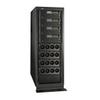Among the other IBM Unix news Tuesday:
A new technology for ensuring high availability for applications, called hot node and repair, will be available later in the quarter for the Power 570 and 595 systems. If a server indicates it is about to fail, the software allows an administrator to shift a workload to a different server while the first server is repaired, and then move back again without losing transactions, according to IBM.
IBM doubled the processor cores available in its System i servers, which run its i OS, to bring them on par with its AIX and Linux offerings. The System i 550, for example, now comes with up to eight processor cores, up from four. IBM said the move completes an effort to offer a common hardware platform for its servers running Linux, AIX or i5/OS.
A new server for mid-size companies, the Power 560 Express, is due on November 21. It uses a 3.6Ghz Power6 processor, comes in four-, eight- and 16-node configurations, and packs a hefty 384G bytes of memory. It's designed for companies looking to run multiple applications on a virtualized system. It will be offered with Linux, AIX or i. Pricing wasn't announced.
IBM said its JS12 Express blade server can now be pre-installed with its i software and attached to its DS3200 storage gear to create a low-cost SAN (storage area network).
Handy said almost two-thirds of IBM's Unix servers shipped in the second quarter included its PowerVM virtualization software, up from 21 percent in the second quarter the year before.

